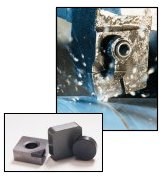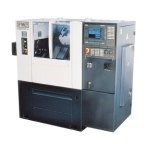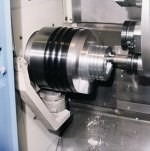Are You Turning Fast Enough?
Let's face it. When most shops go looking for process improvements, turning is seldom at the top of the list. Sure, many shops these days are doing fine work in such areas as reducing lathe setup, combining milling and turning operations on a single machine, and automating workpiece handling functions. But for all the talk of high speed machining and other milling and drilling process improvements, precious little of that kind of thinking is being applied to the turning process itself.
Let's face it. When most shops go looking for process improvements, turning is seldom at the top of the list. Sure, many shops these days are doing fine work in such areas as reducing lathe setup, combining milling and turning operations on a single machine, and automating workpiece handling functions. But for all the talk of high speed machining and other milling and drilling process improvements, precious little of that kind of thinking is being applied to the turning process itself.
There are some good reasons for all that. Chief among them is that milling and drilling processes don't have to deal with centrifugal force barriers the way that turning does. While not a trivial concern, it's still relatively easy to keep a good hold on an end mill spinning at 10,000 rpm. But the prospect of spinning a chucked workpiece that fast will send an experienced lathe operator running for cover.
So as much for safety reasons as anything, shops can be forgiven for taking a conservative view of turning. If you haven't looked recently, however, it's definitely time to reexamine where the upper limits of this process should be. For one thing, new cutting tool technology has dramatically raised the bar on surface speeds, particularly in softer, nonferrous materials. Where 800 sfm was considered fast a decade ago, today's diamond tools are routinely running above 3,000 sfm and capable of going much, much higher.
And finally, a new chuck design has become available that, according to its developers, exhibits no significant grip loss even at extremely high speeds. Now the onus is on the lathe builders to boost their speed capabilities, and some are already beginning to respond. While it's not gotten near the attention of its milling counterpart, high speed turning is on the verge of becoming a practical reality for shops willing to take the leap.
Tangible Benefits
Who should be thinking hard about high speed turning? We posed that question to David Josza, product manager for turning centers at the Monarch Machine Tool Company(Cortland, New York)[now Genesis Worldwide], which markets the Spinner line of high speed turning centers. Spinner currently has an 8,000-rpm turning center (1.25-inch bar capacity) on the market and is in development on a 10,000-rpm model. Mr. Josza says that particularly good candidates are workpieces made of light metals—aluminum, copper, brass or magnesium, for example—that lend themselves to extremely high surface speeds. Those are parts where fairly dramatic reductions in cycle time can be reaped.
Taking a look at recommended cutting speeds for some of today's inserts helps explain how far the cutting tool technology has come. For instance, Kennametal recommends running a number of their PCBN inserts mainly between 1600 and 3400 surface feet, depending on the smoothness of the cut—and that's in cast gray iron. Recommendations for cutting free-machining aluminum go considerably higher. Even with some carbide inserts, surface speeds can easily exceed 3,000 sfm. With polycrystalline diamond grades, the top speeds go through the roof (speaking figuratively of course) at 9,000 sfm and higher.
But cutting cycle time isn't the only reason to boost turning speeds. Another important benefit is the same as what hard turning brought about a generation ago—the ability to eliminate a subsequent grinding operation. "It used to be," says Mr. Josza, "that if you wanted the combination of a good surface finish and a tight tolerance you had little choice but to grind. You could hold a couple `tenths' on size, but a finish of 16 to 32 rms was about the best you could do in production turning. Today it's possible to hold a `tenth' and a finish of 4 to 8 rms. But you can only do that if you have a very accurate machine and if you have the speed. In a lot of applications, that's going to be good enough to eliminate a grind."
Those, of course, are two big "ifs." The accuracy has been around for awhile on better turning machines, but the speed hasn't. And Mr. Josza offers a good example of how that limitation might come into play. Say you want to face off a 4-inch diameter part and want to achieve very high and consistent surface finish. So you run it fast, at 3,000 surface feet. You have a 6,000-rpm lathe and extraordinary faith in your chuck to hold on to the part. But even with all that, you're still going to run out of speed at the 2-inch diameter point. So a compromise will have to be struck somewhere.
Crank It Up
There's always going to be a speed limitation turning down to zero diameter, of course, but the idea is to set that barrier out as far as possible. And up until now, with the exception of small collet-chucked parts, that limit had more to do with workholding than anything else. We're speaking here of chucked parts, and as experienced practitioners know, the combination of high rpm and chucking can be a dangerous mix. Few would purposely leave the constant surface speed function on in an operation like the one described above for fear of losing hold of the part.
The enemy is the centrifugal force that pulls the chuck's jaws outward, and it is a powerful foe indeed. As Richard Hippner, president of Goss & DeLeeuw Workholding (Kensington, Connecticut) puts it, a conventional chuck, even a high speed design, is "cut like a tulip." And eventually those petals are going to bend to escalating centrifugal force, which increases as the square of the rpm. For example, "take a 10-inch chuck with a 1-pound top jaw set at the outer diameter of the face," he says. "At 5,000 rpm, that jaw is going to generate 3550 pounds of force; at 8,000 rpm it's 9,000 pounds; at 10,000 rpm it's 14,200 pounds." That's roughly like hanging three or four automobiles on that chuck jaw. It's got to give a little.
Moreover, just because a chuck's speed rating is set at a certain rpm, that doesn't mean you can actually run it that fast and maintain a safe process, particularly if there are significant cutting forces at play. Historically, a chuck's maximum speed rating was set at the point where it would lose 50 percent of its static gripping force, that is, the force exerted by the jaws on the workpiece when it is at rest. In more recent years the standard (or more precisely, the lack of it) has become looser. Indeed, many manufacturers now state the maximum speed based on where the chuck loses two-thirds of its holding power, and that may still presume a relatively light complement of top jaws. If the top tooling is heavier than nominal, and/or if the jaws are set at a grip diameter greater than nominal, then the fall-off in dynamic gripping force will be all the greater.
Counterbalanced chucks, which have been around for a while, extend the speed range further. While different manufacturers have proprietary elements to their designs, they all work the same in principle. The idea is to use a counterweight within the chuck body to balance whatever centrifugal force is exerted on the chuck jaw. The limitation of this approach, however, is that it must make a fixed assumption about the mass to be counterbalanced. That assumption is typically going to be based on top jaws of medium mass positioned at the midpoint of the stroke. But at very high speeds, a significant grip loss will still occur if the top jaws are heavier and/or if they are positioned at a greater diameter than nominal. Practically speaking, you'll still have to worry about how secure the workpiece is at the top of the speed range because it is impractical to get a perfect counterweight offset for any given application.
What's truly new in high speed turning is a new counterweighted chuck design recently introduced by Goss & DeLeeuw. According to Mr. Hippner, they've successfully operated a 6-inch version of the chuck at speeds beyond 10,000 rpm with virtually no loss in gripping force. Likewise, the smallest 4-inch version is rated at 14,000 rpm and the largest 10-inch version at 7,000 rpm, also with no loss in gripping force. How? Instead of locking the counterweights inside the body, they are placed right on the face of the chuck (see photo) with each master jaw mechanically linked to the wedge-shaped weight located directly opposite. By loosening a single screw, the counterweight can be removed and then machined to bring it to an appropriate mass for the corresponding jaw.
The idea is to keep the chuck face, on which all the significant process masses are mounted, completely balanced like a single spinning disc. The chuck ships with two sets of counterweights of different mass. And according to Goss & DeLeeuw's operations manager, Fernand Boisse, just using one or the other has proven sufficient in applications up to about 5,000 rpm. He cautions, however, that as speeds go higher, additional care will be required: "As you approach 8,000 rpm you are probably going to have to think about balancing the whole job, taking both the chuck and the workpiece into consideration. But if that's done, and you have a good match between the top jaws and counterweights, there's no reason whatsoever why you can't utilize all the speed that lathes today can deliver."
Accessible Technology
So if the tooling is readily available to do high speed turning, and now workholding, what about lathes? Mr. Josza thinks that a lot of people would be surprised to see how much can be accomplished with existing technology—both in terms of speed and accuracy—but also that it's only going to get better. The technology is accessible. Right now on the 8,000-rpm lathe, Spinner publishes linear accuracy of ±0.00002 inch, spindle runout of less than 0.00002 inch, and workpiece roundness within 0.000016 inch—and that's on a $90,000 lathe. While Goss & DeLeeuw is still finalizing its pricing policies, Mr. Hippner says the chucks will be priced comparable to other high speed designs. To be sure, CBN and PCD cutting tools are much more expensive than carbide, but they will pay for themselves many times over if you have the speed to take advantage of their true capabilities.
More speed is coming. Spinner, for example, is nearing completion of its 10,000-rpm (1.25 inch bar) machine, a speed they've already achieved in test conditions. Now the focus is on making sure that kind of performance is achievable on a consistent, long-term basis. Interestingly, these kinds of speeds are forcing lathe spindle makers to deal with many of the same design issues that heretofore have been critical only in high performance milling and grinding spindles. Factors such as balance and vibration are coming to the fore, and in particular, thermal management. Ceramic bearings are probably going to find their way onto the next generation of high speed turning machines, for instance, and lubrication systems may well look a lot more like what we now see on high speed milling machines.
But enough of the speculation. There is ample technology out there right now for many shops to substantially boost the output and surface quality of their turning processes. They just need to take a fresh look at a process that has grown far more capable than most people realize.
Related Content
Twin Spindle Design Doubles Production of Small Parts
After experiencing process stalls in the finishing stage of production, Bryan Machine Service designed an air-powered twin spindle and indexable rotating base to effectively double its production of small parts.
Read MoreHow to Mitigate Chatter to Boost Machining Rates
There are usually better solutions to chatter than just reducing the feed rate. Through vibration analysis, the chatter problem can be solved, enabling much higher metal removal rates, better quality and longer tool life.
Read MoreBuying a Lathe: The Basics
Lathes represent some of the oldest machining technology, but it’s still helpful to remember the basics when considering the purchase of a new turning machine.
Read MoreA New Milling 101: Milling Forces and Formulas
The forces involved in the milling process can be quantified, thus allowing mathematical tools to predict and control these forces. Formulas for calculating these forces accurately make it possible to optimize the quality of milling operations.
Read MoreRead Next
3 Mistakes That Cause CNC Programs to Fail
Despite enhancements to manufacturing technology, there are still issues today that can cause programs to fail. These failures can cause lost time, scrapped parts, damaged machines and even injured operators.
Read MoreThe Cut Scene: The Finer Details of Large-Format Machining
Small details and features can have an outsized impact on large parts, such as Barbco’s collapsible utility drill head.
Read More.png;maxWidth=970;quality=90)





















.png;maxWidth=300;quality=90)


.png;maxWidth=300;quality=90)












